Friendship Bridge
We stayed in Laos for just over two weeks, with one more week that we originally planned for this country consumed by waiting for the Indonesian visa back in Bangkok. At the Friendship Bridge between Thailand and Laos we joined a factory-like procession to get our visas on arrival and after a short waiting time were officially in Laos (but yet without any visible changes from Thailand). The only memorable facts about this unadventurous border crossing were that we almost lost 20 euro on this very simple procedure and that it was the only time in our lives we wouldn’t have minded the waiting time to be a few minutes longer. The money thing was that we were planning to pay the visas in Thai baht and when they quoted us the rate simply assumed that it was equivalent to that in USD – we realized the unbelievable 20 euro difference only at the collection counter but luckily were in time to fix it. And the waiting time thing was that had we queued for something like 10 minutes more we would have skipped the two dollar surcharge for the “overtime” that they levy on you at this border between 6 and 8 am.
Viantiane - tourists and bed bugs
Anyway, the border is basically in Viantiane so after a very short bus ride we arrived at the city centre. Viantiane was unremarkable in every single respect except for how many people were there to see it, which manifested itself in virtually all the hotels (except very high-end) being full. After a thorough search through all of them – both in the guide and not – we found a couple that were in our price range and had a free room, and picked the one that smelt nice :). If only had we known that the nice smell came from the chemicals they used to kill the most aggressive blood-sucking insect we had ever encountered on this trip – bed bugs!!! According to their usual behaviour, as soon as they smelt us these creatures crawled from the furniture to feed on us, and in fact completed their pilgrimage remarkably fast – after 20 minutes of sitting on the bed we already had first bites that were so itchy that we declared a war on these tiny monsters. But it was an unequal battle. Our enemy had the strategic advantage of being invisible and they attacked us during the night with their whole army. We lost… some blood to them. And gained… horrible itchiness for a few days to come. But we learnt a lesson – if a cheap hotel smells too nice, it “smells”, so check the sheets and if you see tiny black dots from baked blood - RUN!!!
During the day we spent in Viantiane we visited one of the oldest temples (Wat Si Saket), the market and the Patuxai gate (a city landmark on an avenue that looks - especially at night, with all the white lights – very much like Champs Elysees.
Wat Si Saket and Jordi:


Patuxai gate and the view from top:


Lots of Soviet legacy in the streets:


Pakse - kittens and motorbikes
The next day we headed down all the way to Pakse which is a hub for a popular motorbike loop through southern Laos. After one-day of “acclimatizing” (a short walk through Pakse, field research on the motorbike rental prices, checking a temple where we found more cats than monks and going back to the hotel to catch up on sleep), the next morning for 6 dollar a day we hired an almost brand new Honda Wave 100cc and started our 6-day motorbike trip which turned out to be the best thing we did in Laos. Here is a short outline of it.
Kittens curled in the monk robes in the temple:


Day 1: Pakse to Tat Lo, 85 km
That day we drove 85 km from Pakse to Tat Lo. The road was fine and we were happy to see that it looked a bit similar to the red roads we loved so much back in Cambodia, with same picturesque villages along the way and friendly locals. We arrived at Tat Lo in time to see the waterfall it’s famous for, then ate a very delicious meal served by very generous portion by the very kind Mama Pap who while we were waiting for the meal told us about her family: “Yes, I have three babies. Baby one – 25 years old, baby two – 20, baby three – 14”. The two elder “babies” are girls and had only a few classes of school, now they help her to run the guesthouse and cook those tasty meals of giant portions, and baby three is her son who will probably be the only one with completed school. We really loved her place even though we hardly managed to sleep that night in our hut – her neighbours had a funeral celebration (no, not a mistype – they do celebrate it in Laos) with very loud Lao music that lasted till the moment we left (at about 8 am next morning). Mama Pap, judging by the apologetic look she had when we chatted with her over a shared breakfast of soursop, must have been sorry for us, but we were much more sorry for her as it was several days in a row that she had been trying to sleep at a party (these funeral celebrations last a few days).
Full tank, please:

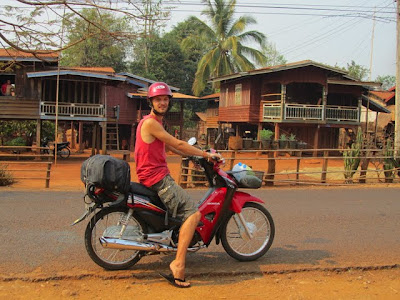
It's very common to see forest fire in Laos (and we have no idea how they keep them under control):


Kids in a house along the road:

Tat Lo waterfall:

Locals playing petanka at the waterfall:
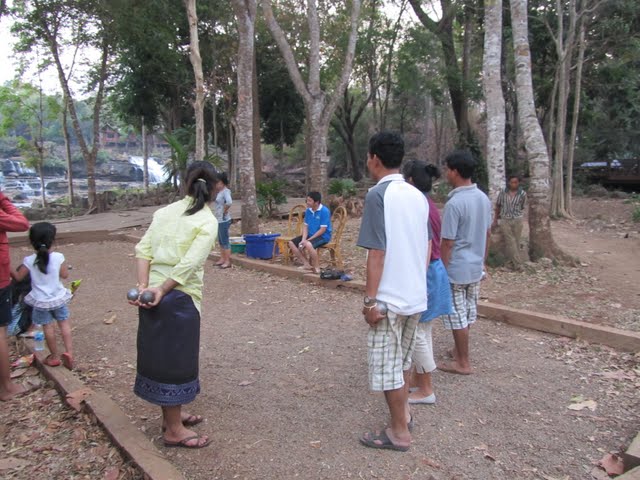
Kids in Tat Lo:
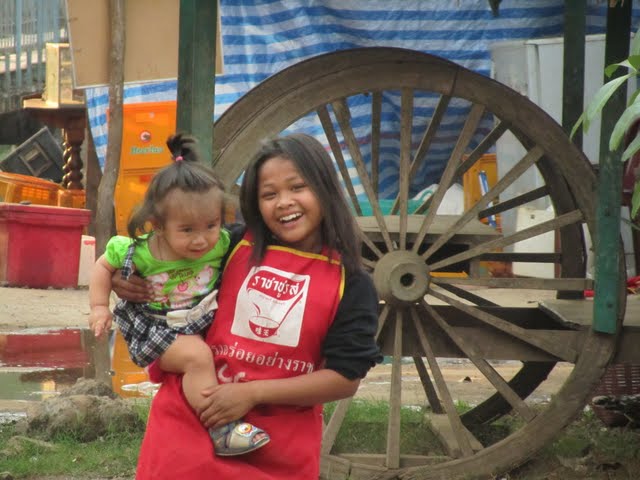
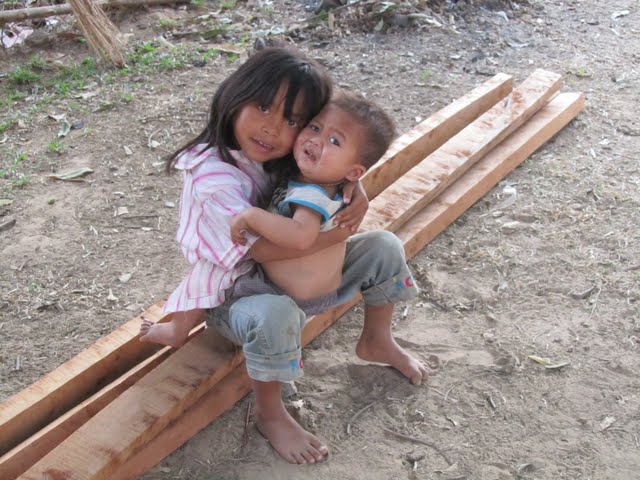
Day 2: Tat Lo - Sekong - Attapeu, 100 km
We left Tat Lo village early in the morning and went to see another big waterfall. As we arrived at the tiny village which was the end of the directions for the waterfall, a small boy at the last house of the village very seriously explained to us in gestures that we could leave the motorbike at his “parking” and he would guide us to the waterfall. Although we could see that we would have no difficulty finding the path (there was only one :) ) we agreed to take his services as somehow it struck us that he takes his “guiding job” very seriously. After a short path down we had a true “wow” feeling as we found ourselves on the rocky top of a really spectacular waterfall. And the best part of it – we had it all to ourselves! Just us, and the birds, and our guide, who grew visibly impatient after a while (probably waiting too long wasn’t part of his job description), so we gave him a little bit of money and told him that we would find our way back. We stayed for another while, sitting at the very edge of the waterfall and watching the water rush past us and form rainbows a few metres down. Truly zen…
On the way to the second Tat Lo waterfall:
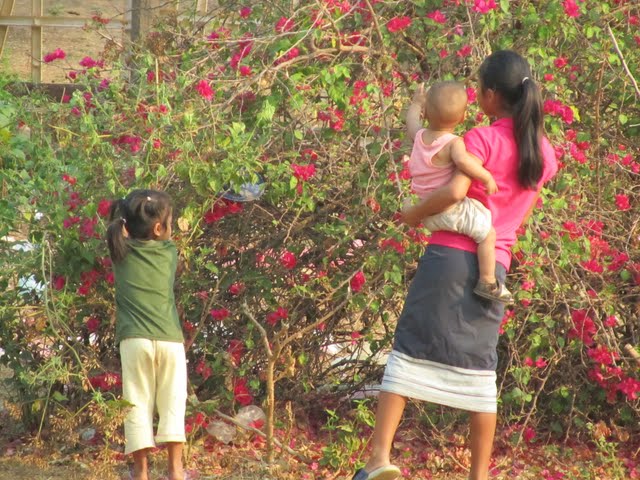
The path down to the waterfall:
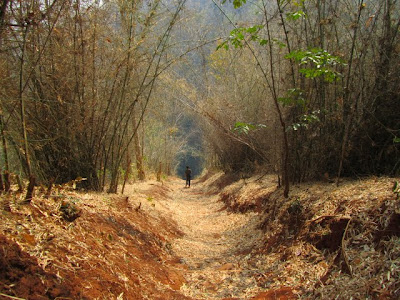

Looking down at the small rainbows below:
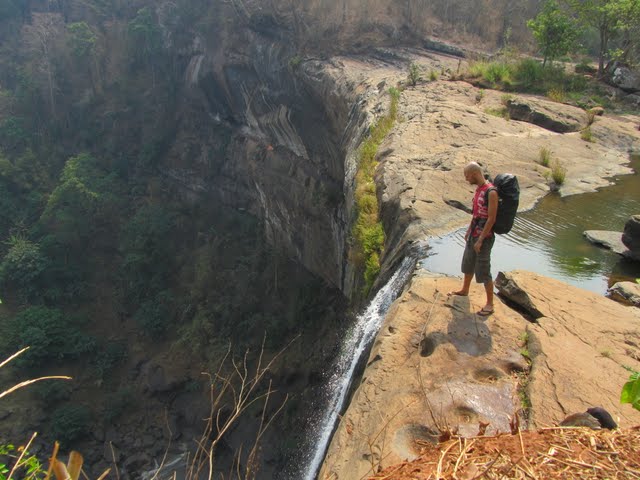
----------------------------------------------------------------------
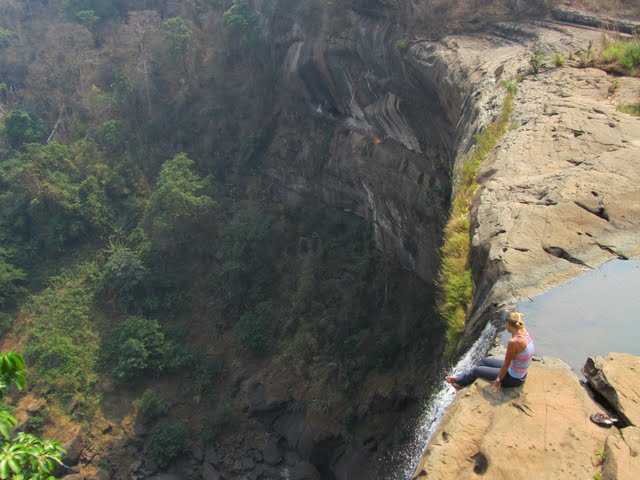
----------------------------------------------------------------------
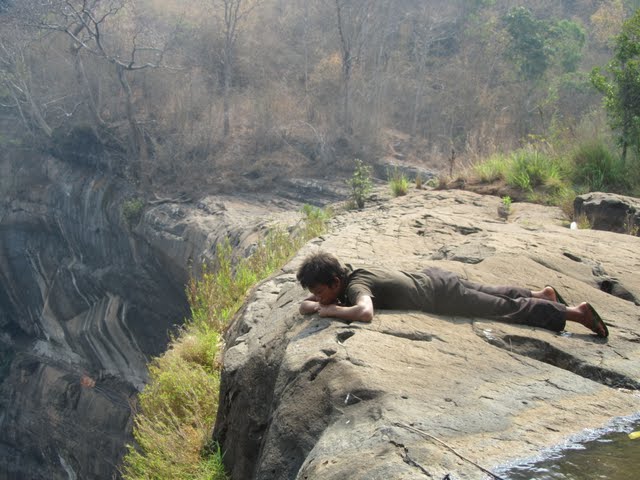
Our "guide" got tired of waiting for us and fell asleep:
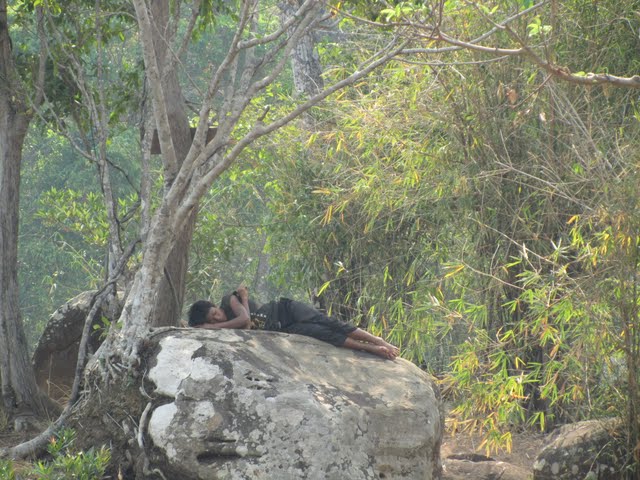
A local girl at the waterfall:
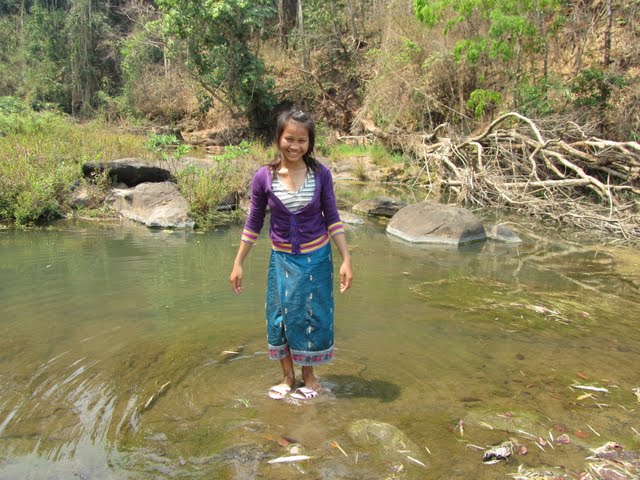
Later that day we drove all the way from Tat Lo to Sekong (55 km) and then to Attapeu (another 45 km). We arrived at Attapeu just in time to find a hotel before it got completely dark, then went to eat at a local canteen and after the meal drove back in complete and utter darkness which was the result of a very short blackout (which strangely enough started the moment we left the canteen and ended the moment we arrived at the hotel).
These three kids were managing the whole gas station:

On the road from Sekong to Attapeu:


-------------------------------------------------------------------------


Kids along the way:


The Adventurous Day 3: Attapeu to Paksong, crossing the Bolaven Plateau and off-road driving on the "half-sealed" muddy road
That day was the most important one of the loop as that’s when we would cross the Bolaven Plateau and see its gorgeous scenery with waterfalls, lost villages and coffee plantations. According to LP, only the first stretch of the road was supposed to be a tough experience and after that we were supposed to breathe in relief as we would hit the semi-sealed stretch that would lead us all the way to Paksong. Well, you know how they say that you can never enter the same river twice? Well, apparently same is true about the roads of Laos, as the 5-hour 20 km drive we had on the semi-sealed road to Paksong was definitely different from the smooth experience that the guys who wrote that LP section must have had (if they had our experience, the Loop would have been recommended only to super-experienced bikers, and as a challenging route).
The few villages that there are on the Bolaven plateau, and especially their inhabitants , are very picturesque:

--------------------------------------------------------------------


These two were selling a huge snake along the road. It was March 8th - the international women's day in (post-)soviet countries, and from what we got the boy caught the snake... Maybe it was his gift to his mum (in Laos, just like in Belarus, a man gives presents to both his mum and girlfriend)...


Everything on this plateau looks red - just like around Ban Lung in Cambodia:


The waterfall we stopped at and the locals:


Coffee plantation:
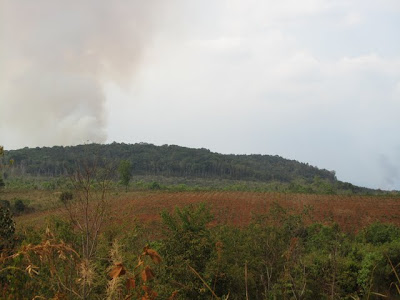

The girls were working even though in was the Women's day - these small coffee plants don't care which date it is:


We ran into these three kids on the plateau - they were pushing this trolley full of half-burnt logs:

---------------------------------------------------------------------
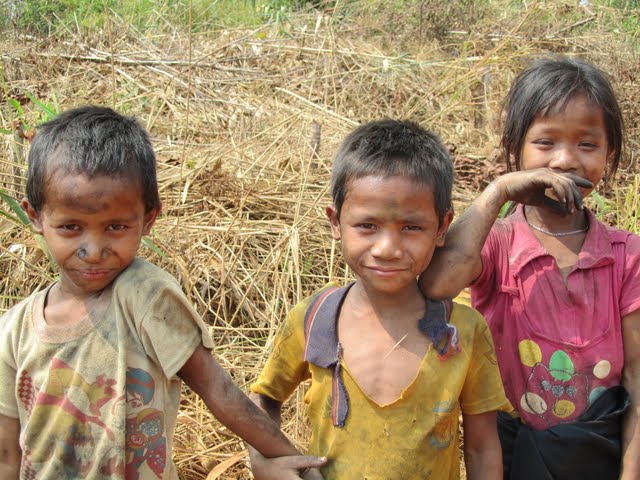
-----------------------------------------------------------------------
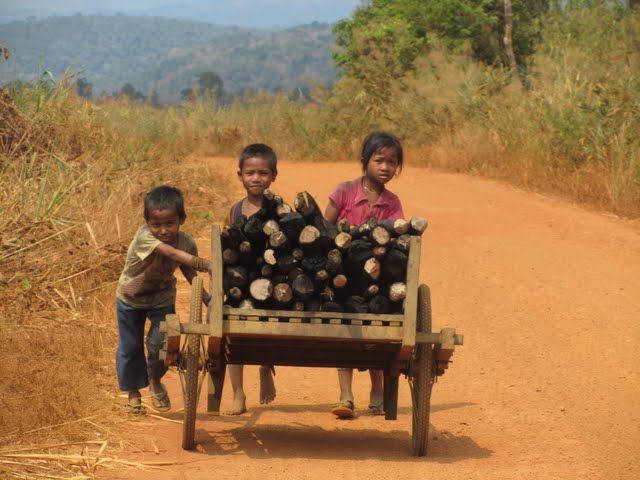
We had a great start on the plateau – on the way we stopped for a really lovely waterfall and shared the view of it with some friendly locals, afterwards we had a short improvised excursion to a coffee plantation as we stopped at one of them and the people who worked there kindly suggested that we have a closer look, then we finally reached the semi-sealed road and a short while later arrived at some village,.. and that’s when we started to smell rain, heavy rain.
We could see the rain coming but didn't know at that time that it would change our afternoon from "easy drive" to "offroad adventure":


Waiting for the rain to stop:


It was so cold we kept our rain coats on even after it stopped raining. It was also getting dark. And the road was pure mud, so we were basically going at the same speed we would be walking:
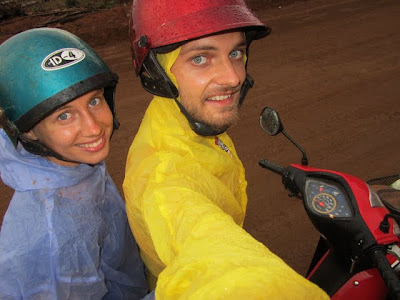

Extra challenges came as we kept finding stretches where they were working on the road (putting pipes etc.) so we had to get off to the side roads. Plus cows - you have to be just as attentive to cows in Laos as to bicycles in the Netherlands:


We thought like all heavy rain it would probably last a short while and stopped at a roadside canteen to have a coffee but as we had waited there for an hour and there was no sign that the rain would stop we decided to continue in the rain in order to make it before dark. We hit the road… only to discover that there was no more road!!! With all the rain of the past hour the “comfortable semi-sealed” surface turned into pure mud that had same grip on our motorbike as ice would. The next 4 hours were one of the worst and best experiences of this trip at the same time and allowed Jordi to grow his motorbike skills exponentially. Imagine a road so slippery that even locals (who seem to start driving a motorbike almost from the day they can reach the pedals) go 5 km/h. Then imagine parts of this road to be covered with such deep mud that even cars had to take a side road with same but thinner mud. And imagine the sun going inevitably more and more down. And then imagine complete darkness, with the dooming prospect of still about 20 km on the same “road” till a place with hotels. Not a light, only an occasional motorbike or a car, only same endless mud and rain. When we had about 10 km left the road got a little better (we could keep a steady 10 km/h without having to drag the motorbike through places where it wouldn’t drive) but it was a very short-lived relief as very soon we discovered that at that stretch of the road they were putting pipes at regular intervals so every km or so we had to get to a side road about 1 metre lower than the main road, drive through slippery mud for a while and then climb back to the road. At about 9 pm exhausted but triumphant we arrived at Paksong, found a hotel, had a meal of delicious noodle soup and fell asleep as soon as our heads touched the pillows.
Day 4: Paksong – Pakse – Si Phan Don (160 km).
Well, having turned into seasoned bikers virtually overnight, the next day instead of the planned 50 km to Pakse we decided to extend our motorbike tour and drive all the way to the south of the country, the so-called 4 Thousand Islands (this is the number of islands they claim to have in this part of the Mekong). Our first idea was to stay at a smaller island Don Det but as we drove there to the ferry point, the locals asked for an unjustifiably high amount to cross the river, so we changed the plan and after enjoying the sunset view, drove back to a hotel we saw along the road in order to cross the next morning to the biggest island of the group – Don Khong. We slept at an enormous ‘villa-like’ hotel, in the morning had some coffee in a company of some British teenagers presenting to their supervisor very uninspired reports about some kind of culture trip they were doing through Laos, then drove to the ferry point for Don Khong and crossed the river.
This day was a long but real easy drive:


Leaving the plateau we saw a lot of drying coffee beans along the road:


We stopped to see another famous waterfall on the way from Paksong to Pakse:

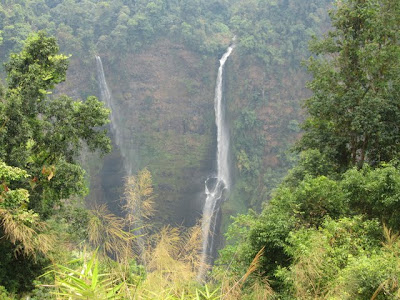
The day was really sunny so compared to the afternoon before it was a really enjoyable drive:


Kids along the way:

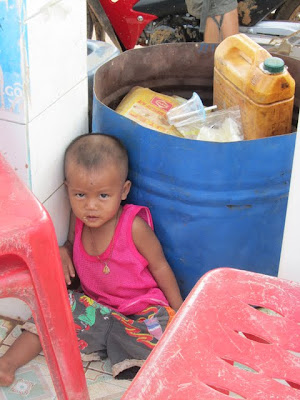
Sunset at the ferry point to Don Det:
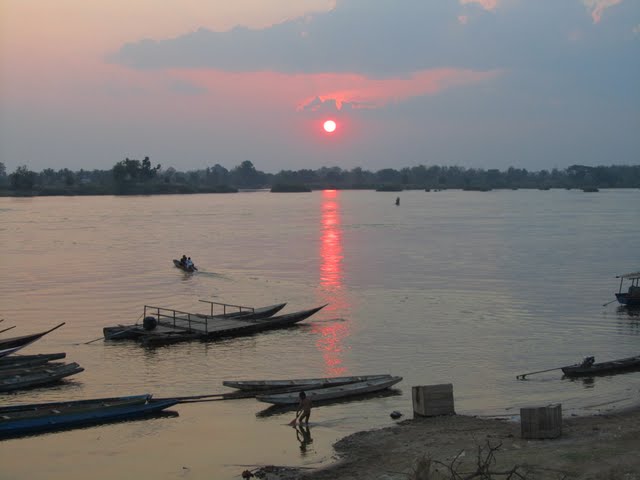
-----------------------------------------------------------------------------


Day 5: Don Khong - an island with no time
We found a hotel and then spent the whole day driving along this tranquil island where time seems to stand still. We watched another amazing sunset over Mekong from a viewpoint inside a temple, then stopped for a Beerlao at a riverside café and then for a meal at another riverside restaurant (yep, it was a whole evening of riverside indulgence :)).


This kid was doing such a great job of that improvised shower:


The omnipresent water buffaloes:


Mekong:


--------------------------------------------------------------------------
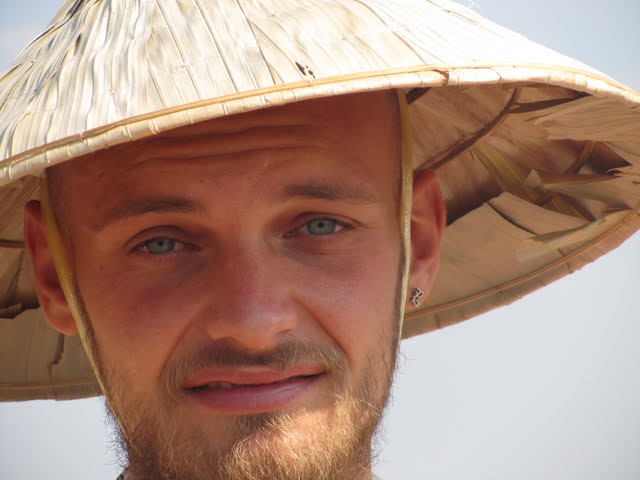
It was my driving shift in Don Khong:
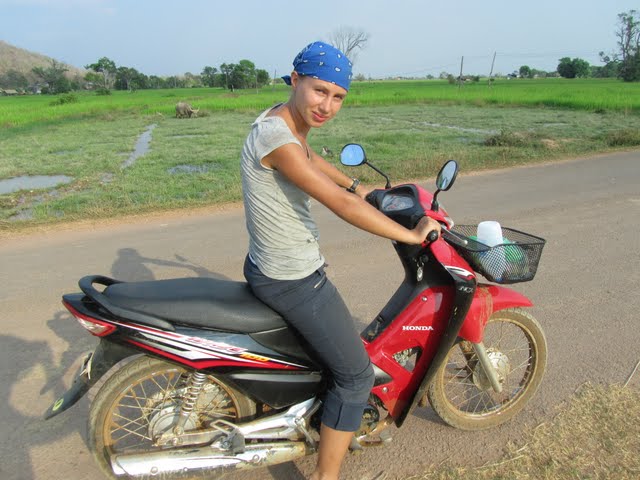
--------------------------------------------------------------------------

--------------------------------------------------------------------------
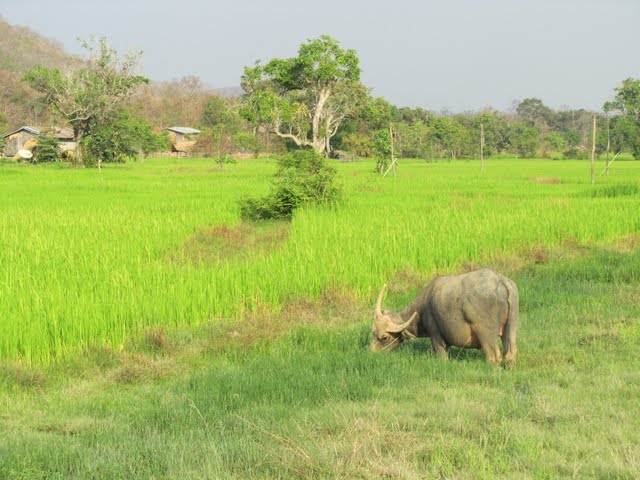
-------------------------------------------------------------------------
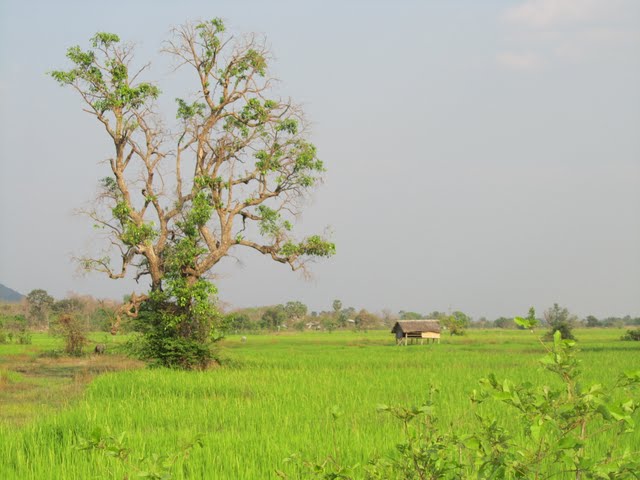
--------------------------------------------------------------------------


Sunset at Don Khong:
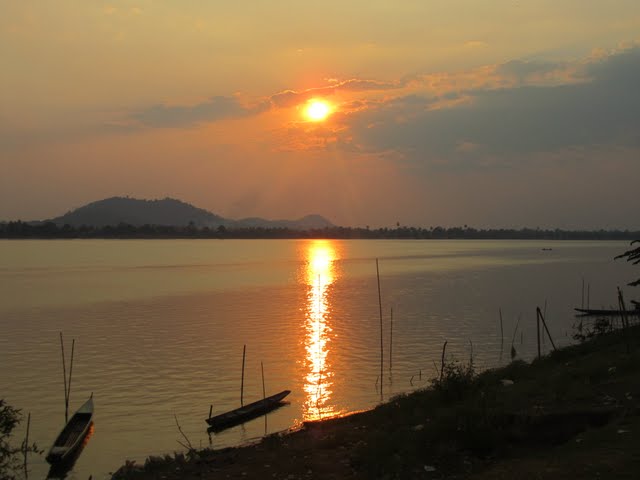
------------------------------------------------------------------------

------------------------------------------------------------------------


Day 6: Don Khong – Champasak – Pakse (166 km).
It was our last motorbike day. I drove the kilometers from Don Khong to Champasak and Jordi took over at the ferry point to Champasak. We drove there in the hope to have a glimpse over a local temple that is built in the same style like Angkor Wat but in the end didn’t really see it as we arrived half an hour before closing time and on the pictures the temple looked like a pale version of what we had seen in Angkor. So we simply enjoyed the rest of our ride through Champasak and then drove all the way back to Pakse. And then we had a more or less typical evening of this stay in Laos: looking for a hotel, finding most of them full, having to look at a bit more expensive ones, getting a fancy room (for our Spartan standards) and enjoying a quiet evening (meal, meditation, reading, TV etc.)
1) Leaving Don Khong. 2) At the ferry point for Champasak.


----------------------------------------------------------------------------

In Champasak:


Refilling gasoline for our last stretch to Pakse:

Tha Khaek - Catalan couple and Chinese motorbike
Next morning we left for Tha Khaek closer to the centre of Laos where we were considering making another motorbike loop. This city had nothing in particular about it apart from very mean locals (no kidding, it was the second time we were passing through this place, and at almost every small encounter with the locals they would quote us prices two times higher than in the rest of the country and would not bargain, as if they had some “foreigner pact” or something). During our search for a hotel we ran into a Catalan couple and had a great evening chatting with them about our backpacking Asia. Jordi and Lidia from Sant Celoni started their round-the-world trip with an itinerary very similar to ours a couple of months ago so we had loads of tips to share and lots of jokes to exchange about communication style of Asian people. After the usual long search for a vacant room, we managed to find two rooms at a small but very cute hotel and spent the rest of the evening chatting.
Next morning the guys left for the south of Laos and we went to check the prices of the motorbikes. With only a couple rental places compared to many in Pakse, the prices were correspondingly almost double. By the time we were done with the market research, there were only two bikes left at one of the places, and another traveler was choosing the better one of the two. Our hearts sank as we saw what miserable piece of Chinese production he eventually left behind. It had a broken key that had to be removed before driving (not to lose it), non-working meters and no electric ignition. Our hearts sank even lower as we heard the engine of that bike that sounded more like “I want to retire” rather than “I will go all the way with you, through dust roads, hills and mud”. But very willing to give the loop a try, we ignored what intuition was telling us and rented the bike. Probably tired of “talking gently”, providence almost shouted at us when Jordi hurt himself badly while trying to start that bike 5 minutes later with a manual start pedal. As the bike had only two drops of gasoline inside (the guys at the rental place hadn’t bothered to put enough even to reach the gas station) the bike wasn’t starting and after several futile attempts Jordi got a very deep scratch by hitting the unprotected sharp edge of an adjacent pedal. The sight of blood oozing out of that wound must have sobered us up as in the next minute we said almost simultaneously that we were not going on a loop with that veteran bike, so we brought it back and the same day left for the north of the country.
This was our last 'drop' for making the decision not to do a loop around Tha Khaek on that piece of junk they rented to us instead of a motorbike:


Viantiane - full hotels and Lao kip image
By that time we had only 4 days left in the country before leaving for Vietnam so we decided to see a bit of the north of Laos. We headed to Phonsavan to see its mysterious Plain of Jars (it’s kind of Asian Stone Hedge). On the way to Phonsavan we had to spend yet another night in just as full and just as unremarkable Viantiane as we didn’t have time to catch the night bus to the north. This time we had a good night’s sleep without any blood-sucking monsters in a different hotel (we knew this one from the previous search and had in mind as a more expensive backup plan which came in handy now that everything was so full). Next day to pass the time before the late bus to the north we went to see Pha That Luang – the pagoda depicted on the Lao kip.
----------------------------------------------------------------------------------
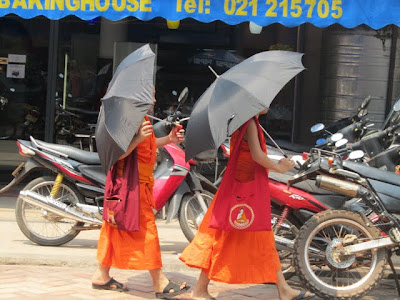

--------------------------------------------------------------------------
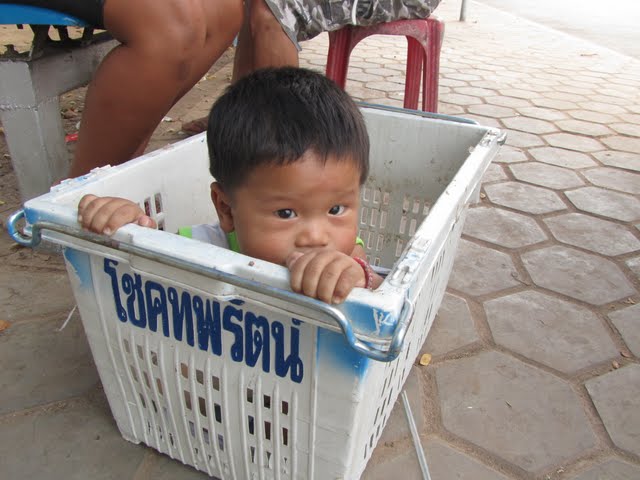
This building is the symbolic image of Laos on this country's currency - Lao kip:


Later that day we took our bags and headed for the local bus station. But the bus we took there to go to the northern bus station after about 1 km it broke down. The driver managed to start the engine a couple more times and drove small stretches, but it was getting obvious that that bus would not reach the station so we left it and started walking. According to LP it should have been a gentle 2-3 km walk and locals said the same. But as we should have been at most 1 km away from the station, a tuk-tuk driver stopped to ask whether we wanted a drive and quoted a price too high for such a tiny ride. But at that same moment providence sent us a message. As we were talking with the tuk-tuk driver, a western guy stopped next to us in his car and asked us if we were going to the station. We said “yes” and he said that we must definitely take that tuk-tuk since the station had been moved and was now about 8 km away. A few minutes later having seen all the kilometers we would have had to walk, we felt really grateful to that stranger for his tip regarding tuk-tuk, and even more so because by that time it started raining really hard.
Phonsavan - jars and rain
Next day as we opened our eyes at Phonsavan station, to our huge disappointment we saw that it was still raining. Never mind, we said, it should clear up later today… Sure! It’s been a week now since that first rain in Viantiane and we have travelled a lot of kilometers all the way to Hanoi but IT IS STILL RAINING!
Nothing but rain in Phonsavan, the only time we felt warm in this city was while eating at this local canteen run by very friendly women:


Horrifying facts about UXO:


These steel remnants are used all over Phonsavan as 'decoration':


Anyway, we waited the whole first day with our naïve hope that it would stop raining... and then the whole next day… There was absolutely nothing to do in that city, the rain wouldn’t stop for a minute, it was about 10-12 degrees outside and we had no coats, so … luckily we had a TV in the room. But then came the last day that we could spend in Laos before leaving for Vietnam so we put on our rain coats and started walking to the Jars. This time we did opt for an 8-km walk (each way) as with the couple miserable tuk-tuks that they had in that city they were quoting the prices for a return trip comparable to a bus ticket to Vietnam. We arrived at the Jars about 1.5 hour later, our trousers and shoes soaked through and both of us feeling very cold. So (duly impressed but frozen) we gave the jars a very quick look and headed back. On the way back we decided to try our luck with hitchhiking and waved down a pickup. To our big surprise it stopped and we saw two cows lying in the back of that pickup. Later as we were “talking” to the young guys in the cabin we understood that the cows have died (or got very sick) from the cold. Well, those cows might have been beyond saving but we still could be saved so luckily for us those guys have delivered us almost at our hotel. A warm shower, a good night’s sleep and next morning we were up at 4.30 am to get our bus to Vinh in Vietnam.
At the Plain of Jars:

-----------------------------------------------------------------------


------------------------------------------------------------------------


----------------------------------------------------------------------------

These cows either got sick or died from cold - luckily we are more resistant than them:
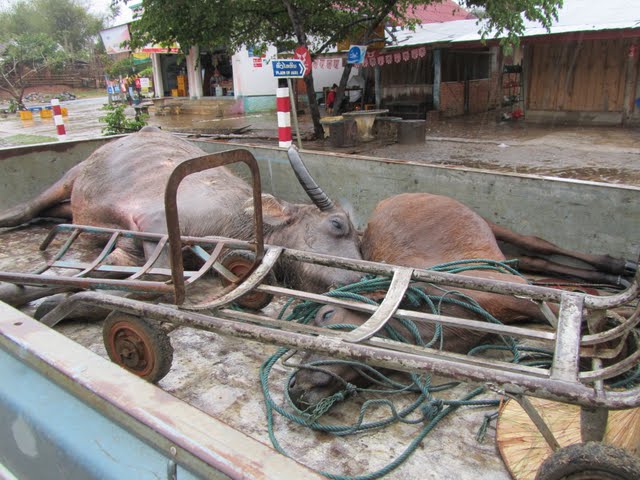
This time we were really willing to get one of those few tuk-tuks for the drive to the station but as we were walking down the street in complete darkness we didn’t see a single one coming. It was raining quite hard so we stopped at some stall that had a roof and bright light and waited there for about half an hour trying to stop cars. Finally, providence (who else could it be the way things were shaping themselves lately :) ) sent a tuk-tuk with two travelers our way who were heading for the same bus like us. We shared the tuk-tuk with them and one hour later we finally left Phonsavan behind with big hopes that as soon as we cross the border we would see the shine of the Vietnamese sun. Well, as you already know, we didn’t, and we haven’t, at least not yet, and I’ll tell you if we will have seen any (wow, what a row of English tenses) in the next post about Vietnam.
Closing notes
A few closing notes on Laos. In general, we had mixed feeling about this country. We didn’t find it as colourful as Cambodia but it did have some very unique landscapes. The people were also not so friendly (definitely far from the genuinely friendly and always smiling people we found in Cambodia). But we really loved our motorbike adventure and from what we saw Laos is a great place to have one. As to the expenses, we used to hear that Laos is cheap… Well, maybe because it was the peak of high season but we found most hotels full and more expensive than elsewhere in Asia (we had to spend on average 7-10 dollar). Food lacked variety so we had to go by on the eternal noodle soup, about 1.25 dollar which is also more expensive than elsewhere in Asia… But we really loved the Lao coffee - “nom hawn”, or with milk for me, and black for Jordi.
Food - noodle soup, fried rice and coffee
Noodle soup in this country is served with a plate of greens:


Fried rice and sticky rice:


Some fruit we tried:
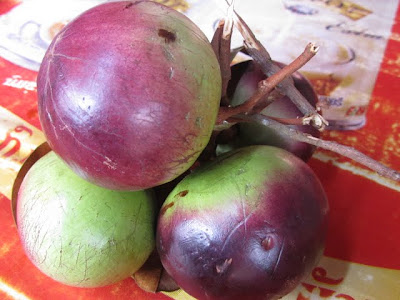

Bread - probably due to French legacy - is very good in Laos:


Coffee - Vietnamese (very short) and Lao style:


-------------------------------------------------------------------------
Several ways to transport a motorbike on a bus
In Laos we've seen most ways to transport a motorbike on a bus. Method # 1 - on the roof:


Method #2 and #3 - in the passenger space and in the luggage department:


We stayed in Laos for just over two weeks, with one more week that we originally planned for this country consumed by waiting for the Indonesian visa back in Bangkok. At the Friendship Bridge between Thailand and Laos we joined a factory-like procession to get our visas on arrival and after a short waiting time were officially in Laos (but yet without any visible changes from Thailand). The only memorable facts about this unadventurous border crossing were that we almost lost 20 euro on this very simple procedure and that it was the only time in our lives we wouldn’t have minded the waiting time to be a few minutes longer. The money thing was that we were planning to pay the visas in Thai baht and when they quoted us the rate simply assumed that it was equivalent to that in USD – we realized the unbelievable 20 euro difference only at the collection counter but luckily were in time to fix it. And the waiting time thing was that had we queued for something like 10 minutes more we would have skipped the two dollar surcharge for the “overtime” that they levy on you at this border between 6 and 8 am.
Viantiane - tourists and bed bugs
Anyway, the border is basically in Viantiane so after a very short bus ride we arrived at the city centre. Viantiane was unremarkable in every single respect except for how many people were there to see it, which manifested itself in virtually all the hotels (except very high-end) being full. After a thorough search through all of them – both in the guide and not – we found a couple that were in our price range and had a free room, and picked the one that smelt nice :). If only had we known that the nice smell came from the chemicals they used to kill the most aggressive blood-sucking insect we had ever encountered on this trip – bed bugs!!! According to their usual behaviour, as soon as they smelt us these creatures crawled from the furniture to feed on us, and in fact completed their pilgrimage remarkably fast – after 20 minutes of sitting on the bed we already had first bites that were so itchy that we declared a war on these tiny monsters. But it was an unequal battle. Our enemy had the strategic advantage of being invisible and they attacked us during the night with their whole army. We lost… some blood to them. And gained… horrible itchiness for a few days to come. But we learnt a lesson – if a cheap hotel smells too nice, it “smells”, so check the sheets and if you see tiny black dots from baked blood - RUN!!!
During the day we spent in Viantiane we visited one of the oldest temples (Wat Si Saket), the market and the Patuxai gate (a city landmark on an avenue that looks - especially at night, with all the white lights – very much like Champs Elysees.
Wat Si Saket and Jordi:
Patuxai gate and the view from top:
Lots of Soviet legacy in the streets:
Pakse - kittens and motorbikes
The next day we headed down all the way to Pakse which is a hub for a popular motorbike loop through southern Laos. After one-day of “acclimatizing” (a short walk through Pakse, field research on the motorbike rental prices, checking a temple where we found more cats than monks and going back to the hotel to catch up on sleep), the next morning for 6 dollar a day we hired an almost brand new Honda Wave 100cc and started our 6-day motorbike trip which turned out to be the best thing we did in Laos. Here is a short outline of it.
Kittens curled in the monk robes in the temple:
Day 1: Pakse to Tat Lo, 85 km
That day we drove 85 km from Pakse to Tat Lo. The road was fine and we were happy to see that it looked a bit similar to the red roads we loved so much back in Cambodia, with same picturesque villages along the way and friendly locals. We arrived at Tat Lo in time to see the waterfall it’s famous for, then ate a very delicious meal served by very generous portion by the very kind Mama Pap who while we were waiting for the meal told us about her family: “Yes, I have three babies. Baby one – 25 years old, baby two – 20, baby three – 14”. The two elder “babies” are girls and had only a few classes of school, now they help her to run the guesthouse and cook those tasty meals of giant portions, and baby three is her son who will probably be the only one with completed school. We really loved her place even though we hardly managed to sleep that night in our hut – her neighbours had a funeral celebration (no, not a mistype – they do celebrate it in Laos) with very loud Lao music that lasted till the moment we left (at about 8 am next morning). Mama Pap, judging by the apologetic look she had when we chatted with her over a shared breakfast of soursop, must have been sorry for us, but we were much more sorry for her as it was several days in a row that she had been trying to sleep at a party (these funeral celebrations last a few days).
Full tank, please:
It's very common to see forest fire in Laos (and we have no idea how they keep them under control):
Kids in a house along the road:
Tat Lo waterfall:
Locals playing petanka at the waterfall:
Kids in Tat Lo:
Day 2: Tat Lo - Sekong - Attapeu, 100 km
We left Tat Lo village early in the morning and went to see another big waterfall. As we arrived at the tiny village which was the end of the directions for the waterfall, a small boy at the last house of the village very seriously explained to us in gestures that we could leave the motorbike at his “parking” and he would guide us to the waterfall. Although we could see that we would have no difficulty finding the path (there was only one :) ) we agreed to take his services as somehow it struck us that he takes his “guiding job” very seriously. After a short path down we had a true “wow” feeling as we found ourselves on the rocky top of a really spectacular waterfall. And the best part of it – we had it all to ourselves! Just us, and the birds, and our guide, who grew visibly impatient after a while (probably waiting too long wasn’t part of his job description), so we gave him a little bit of money and told him that we would find our way back. We stayed for another while, sitting at the very edge of the waterfall and watching the water rush past us and form rainbows a few metres down. Truly zen…
On the way to the second Tat Lo waterfall:
The path down to the waterfall:
Looking down at the small rainbows below:
----------------------------------------------------------------------
----------------------------------------------------------------------
Our "guide" got tired of waiting for us and fell asleep:
A local girl at the waterfall:
Later that day we drove all the way from Tat Lo to Sekong (55 km) and then to Attapeu (another 45 km). We arrived at Attapeu just in time to find a hotel before it got completely dark, then went to eat at a local canteen and after the meal drove back in complete and utter darkness which was the result of a very short blackout (which strangely enough started the moment we left the canteen and ended the moment we arrived at the hotel).
These three kids were managing the whole gas station:
On the road from Sekong to Attapeu:
-------------------------------------------------------------------------
Kids along the way:
The Adventurous Day 3: Attapeu to Paksong, crossing the Bolaven Plateau and off-road driving on the "half-sealed" muddy road
That day was the most important one of the loop as that’s when we would cross the Bolaven Plateau and see its gorgeous scenery with waterfalls, lost villages and coffee plantations. According to LP, only the first stretch of the road was supposed to be a tough experience and after that we were supposed to breathe in relief as we would hit the semi-sealed stretch that would lead us all the way to Paksong. Well, you know how they say that you can never enter the same river twice? Well, apparently same is true about the roads of Laos, as the 5-hour 20 km drive we had on the semi-sealed road to Paksong was definitely different from the smooth experience that the guys who wrote that LP section must have had (if they had our experience, the Loop would have been recommended only to super-experienced bikers, and as a challenging route).
The few villages that there are on the Bolaven plateau, and especially their inhabitants , are very picturesque:
--------------------------------------------------------------------
These two were selling a huge snake along the road. It was March 8th - the international women's day in (post-)soviet countries, and from what we got the boy caught the snake... Maybe it was his gift to his mum (in Laos, just like in Belarus, a man gives presents to both his mum and girlfriend)...
Everything on this plateau looks red - just like around Ban Lung in Cambodia:
The waterfall we stopped at and the locals:
Coffee plantation:
The girls were working even though in was the Women's day - these small coffee plants don't care which date it is:
We ran into these three kids on the plateau - they were pushing this trolley full of half-burnt logs:
---------------------------------------------------------------------
-----------------------------------------------------------------------
We had a great start on the plateau – on the way we stopped for a really lovely waterfall and shared the view of it with some friendly locals, afterwards we had a short improvised excursion to a coffee plantation as we stopped at one of them and the people who worked there kindly suggested that we have a closer look, then we finally reached the semi-sealed road and a short while later arrived at some village,.. and that’s when we started to smell rain, heavy rain.
We could see the rain coming but didn't know at that time that it would change our afternoon from "easy drive" to "offroad adventure":
Waiting for the rain to stop:
It was so cold we kept our rain coats on even after it stopped raining. It was also getting dark. And the road was pure mud, so we were basically going at the same speed we would be walking:
Extra challenges came as we kept finding stretches where they were working on the road (putting pipes etc.) so we had to get off to the side roads. Plus cows - you have to be just as attentive to cows in Laos as to bicycles in the Netherlands:
We thought like all heavy rain it would probably last a short while and stopped at a roadside canteen to have a coffee but as we had waited there for an hour and there was no sign that the rain would stop we decided to continue in the rain in order to make it before dark. We hit the road… only to discover that there was no more road!!! With all the rain of the past hour the “comfortable semi-sealed” surface turned into pure mud that had same grip on our motorbike as ice would. The next 4 hours were one of the worst and best experiences of this trip at the same time and allowed Jordi to grow his motorbike skills exponentially. Imagine a road so slippery that even locals (who seem to start driving a motorbike almost from the day they can reach the pedals) go 5 km/h. Then imagine parts of this road to be covered with such deep mud that even cars had to take a side road with same but thinner mud. And imagine the sun going inevitably more and more down. And then imagine complete darkness, with the dooming prospect of still about 20 km on the same “road” till a place with hotels. Not a light, only an occasional motorbike or a car, only same endless mud and rain. When we had about 10 km left the road got a little better (we could keep a steady 10 km/h without having to drag the motorbike through places where it wouldn’t drive) but it was a very short-lived relief as very soon we discovered that at that stretch of the road they were putting pipes at regular intervals so every km or so we had to get to a side road about 1 metre lower than the main road, drive through slippery mud for a while and then climb back to the road. At about 9 pm exhausted but triumphant we arrived at Paksong, found a hotel, had a meal of delicious noodle soup and fell asleep as soon as our heads touched the pillows.
Day 4: Paksong – Pakse – Si Phan Don (160 km).
Well, having turned into seasoned bikers virtually overnight, the next day instead of the planned 50 km to Pakse we decided to extend our motorbike tour and drive all the way to the south of the country, the so-called 4 Thousand Islands (this is the number of islands they claim to have in this part of the Mekong). Our first idea was to stay at a smaller island Don Det but as we drove there to the ferry point, the locals asked for an unjustifiably high amount to cross the river, so we changed the plan and after enjoying the sunset view, drove back to a hotel we saw along the road in order to cross the next morning to the biggest island of the group – Don Khong. We slept at an enormous ‘villa-like’ hotel, in the morning had some coffee in a company of some British teenagers presenting to their supervisor very uninspired reports about some kind of culture trip they were doing through Laos, then drove to the ferry point for Don Khong and crossed the river.
This day was a long but real easy drive:
Leaving the plateau we saw a lot of drying coffee beans along the road:
We stopped to see another famous waterfall on the way from Paksong to Pakse:
The day was really sunny so compared to the afternoon before it was a really enjoyable drive:
Kids along the way:
Sunset at the ferry point to Don Det:
-----------------------------------------------------------------------------
Day 5: Don Khong - an island with no time
We found a hotel and then spent the whole day driving along this tranquil island where time seems to stand still. We watched another amazing sunset over Mekong from a viewpoint inside a temple, then stopped for a Beerlao at a riverside café and then for a meal at another riverside restaurant (yep, it was a whole evening of riverside indulgence :)).
This kid was doing such a great job of that improvised shower:
The omnipresent water buffaloes:
Mekong:
--------------------------------------------------------------------------
It was my driving shift in Don Khong:
--------------------------------------------------------------------------
--------------------------------------------------------------------------
-------------------------------------------------------------------------
--------------------------------------------------------------------------
Sunset at Don Khong:
------------------------------------------------------------------------
------------------------------------------------------------------------
Day 6: Don Khong – Champasak – Pakse (166 km).
It was our last motorbike day. I drove the kilometers from Don Khong to Champasak and Jordi took over at the ferry point to Champasak. We drove there in the hope to have a glimpse over a local temple that is built in the same style like Angkor Wat but in the end didn’t really see it as we arrived half an hour before closing time and on the pictures the temple looked like a pale version of what we had seen in Angkor. So we simply enjoyed the rest of our ride through Champasak and then drove all the way back to Pakse. And then we had a more or less typical evening of this stay in Laos: looking for a hotel, finding most of them full, having to look at a bit more expensive ones, getting a fancy room (for our Spartan standards) and enjoying a quiet evening (meal, meditation, reading, TV etc.)
1) Leaving Don Khong. 2) At the ferry point for Champasak.
----------------------------------------------------------------------------
In Champasak:
Refilling gasoline for our last stretch to Pakse:
Tha Khaek - Catalan couple and Chinese motorbike
Next morning we left for Tha Khaek closer to the centre of Laos where we were considering making another motorbike loop. This city had nothing in particular about it apart from very mean locals (no kidding, it was the second time we were passing through this place, and at almost every small encounter with the locals they would quote us prices two times higher than in the rest of the country and would not bargain, as if they had some “foreigner pact” or something). During our search for a hotel we ran into a Catalan couple and had a great evening chatting with them about our backpacking Asia. Jordi and Lidia from Sant Celoni started their round-the-world trip with an itinerary very similar to ours a couple of months ago so we had loads of tips to share and lots of jokes to exchange about communication style of Asian people. After the usual long search for a vacant room, we managed to find two rooms at a small but very cute hotel and spent the rest of the evening chatting.
Next morning the guys left for the south of Laos and we went to check the prices of the motorbikes. With only a couple rental places compared to many in Pakse, the prices were correspondingly almost double. By the time we were done with the market research, there were only two bikes left at one of the places, and another traveler was choosing the better one of the two. Our hearts sank as we saw what miserable piece of Chinese production he eventually left behind. It had a broken key that had to be removed before driving (not to lose it), non-working meters and no electric ignition. Our hearts sank even lower as we heard the engine of that bike that sounded more like “I want to retire” rather than “I will go all the way with you, through dust roads, hills and mud”. But very willing to give the loop a try, we ignored what intuition was telling us and rented the bike. Probably tired of “talking gently”, providence almost shouted at us when Jordi hurt himself badly while trying to start that bike 5 minutes later with a manual start pedal. As the bike had only two drops of gasoline inside (the guys at the rental place hadn’t bothered to put enough even to reach the gas station) the bike wasn’t starting and after several futile attempts Jordi got a very deep scratch by hitting the unprotected sharp edge of an adjacent pedal. The sight of blood oozing out of that wound must have sobered us up as in the next minute we said almost simultaneously that we were not going on a loop with that veteran bike, so we brought it back and the same day left for the north of the country.
This was our last 'drop' for making the decision not to do a loop around Tha Khaek on that piece of junk they rented to us instead of a motorbike:
Viantiane - full hotels and Lao kip image
By that time we had only 4 days left in the country before leaving for Vietnam so we decided to see a bit of the north of Laos. We headed to Phonsavan to see its mysterious Plain of Jars (it’s kind of Asian Stone Hedge). On the way to Phonsavan we had to spend yet another night in just as full and just as unremarkable Viantiane as we didn’t have time to catch the night bus to the north. This time we had a good night’s sleep without any blood-sucking monsters in a different hotel (we knew this one from the previous search and had in mind as a more expensive backup plan which came in handy now that everything was so full). Next day to pass the time before the late bus to the north we went to see Pha That Luang – the pagoda depicted on the Lao kip.
----------------------------------------------------------------------------------
--------------------------------------------------------------------------
This building is the symbolic image of Laos on this country's currency - Lao kip:
Later that day we took our bags and headed for the local bus station. But the bus we took there to go to the northern bus station after about 1 km it broke down. The driver managed to start the engine a couple more times and drove small stretches, but it was getting obvious that that bus would not reach the station so we left it and started walking. According to LP it should have been a gentle 2-3 km walk and locals said the same. But as we should have been at most 1 km away from the station, a tuk-tuk driver stopped to ask whether we wanted a drive and quoted a price too high for such a tiny ride. But at that same moment providence sent us a message. As we were talking with the tuk-tuk driver, a western guy stopped next to us in his car and asked us if we were going to the station. We said “yes” and he said that we must definitely take that tuk-tuk since the station had been moved and was now about 8 km away. A few minutes later having seen all the kilometers we would have had to walk, we felt really grateful to that stranger for his tip regarding tuk-tuk, and even more so because by that time it started raining really hard.
Phonsavan - jars and rain
Next day as we opened our eyes at Phonsavan station, to our huge disappointment we saw that it was still raining. Never mind, we said, it should clear up later today… Sure! It’s been a week now since that first rain in Viantiane and we have travelled a lot of kilometers all the way to Hanoi but IT IS STILL RAINING!
Nothing but rain in Phonsavan, the only time we felt warm in this city was while eating at this local canteen run by very friendly women:
Horrifying facts about UXO:
These steel remnants are used all over Phonsavan as 'decoration':
Anyway, we waited the whole first day with our naïve hope that it would stop raining... and then the whole next day… There was absolutely nothing to do in that city, the rain wouldn’t stop for a minute, it was about 10-12 degrees outside and we had no coats, so … luckily we had a TV in the room. But then came the last day that we could spend in Laos before leaving for Vietnam so we put on our rain coats and started walking to the Jars. This time we did opt for an 8-km walk (each way) as with the couple miserable tuk-tuks that they had in that city they were quoting the prices for a return trip comparable to a bus ticket to Vietnam. We arrived at the Jars about 1.5 hour later, our trousers and shoes soaked through and both of us feeling very cold. So (duly impressed but frozen) we gave the jars a very quick look and headed back. On the way back we decided to try our luck with hitchhiking and waved down a pickup. To our big surprise it stopped and we saw two cows lying in the back of that pickup. Later as we were “talking” to the young guys in the cabin we understood that the cows have died (or got very sick) from the cold. Well, those cows might have been beyond saving but we still could be saved so luckily for us those guys have delivered us almost at our hotel. A warm shower, a good night’s sleep and next morning we were up at 4.30 am to get our bus to Vinh in Vietnam.
At the Plain of Jars:
-----------------------------------------------------------------------
------------------------------------------------------------------------
----------------------------------------------------------------------------
These cows either got sick or died from cold - luckily we are more resistant than them:
This time we were really willing to get one of those few tuk-tuks for the drive to the station but as we were walking down the street in complete darkness we didn’t see a single one coming. It was raining quite hard so we stopped at some stall that had a roof and bright light and waited there for about half an hour trying to stop cars. Finally, providence (who else could it be the way things were shaping themselves lately :) ) sent a tuk-tuk with two travelers our way who were heading for the same bus like us. We shared the tuk-tuk with them and one hour later we finally left Phonsavan behind with big hopes that as soon as we cross the border we would see the shine of the Vietnamese sun. Well, as you already know, we didn’t, and we haven’t, at least not yet, and I’ll tell you if we will have seen any (wow, what a row of English tenses) in the next post about Vietnam.
Closing notes
A few closing notes on Laos. In general, we had mixed feeling about this country. We didn’t find it as colourful as Cambodia but it did have some very unique landscapes. The people were also not so friendly (definitely far from the genuinely friendly and always smiling people we found in Cambodia). But we really loved our motorbike adventure and from what we saw Laos is a great place to have one. As to the expenses, we used to hear that Laos is cheap… Well, maybe because it was the peak of high season but we found most hotels full and more expensive than elsewhere in Asia (we had to spend on average 7-10 dollar). Food lacked variety so we had to go by on the eternal noodle soup, about 1.25 dollar which is also more expensive than elsewhere in Asia… But we really loved the Lao coffee - “nom hawn”, or with milk for me, and black for Jordi.
Food - noodle soup, fried rice and coffee
Noodle soup in this country is served with a plate of greens:
Fried rice and sticky rice:
Some fruit we tried:
Bread - probably due to French legacy - is very good in Laos:
Coffee - Vietnamese (very short) and Lao style:
-------------------------------------------------------------------------
Several ways to transport a motorbike on a bus
In Laos we've seen most ways to transport a motorbike on a bus. Method # 1 - on the roof:
Method #2 and #3 - in the passenger space and in the luggage department:
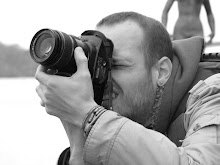.jpg)



